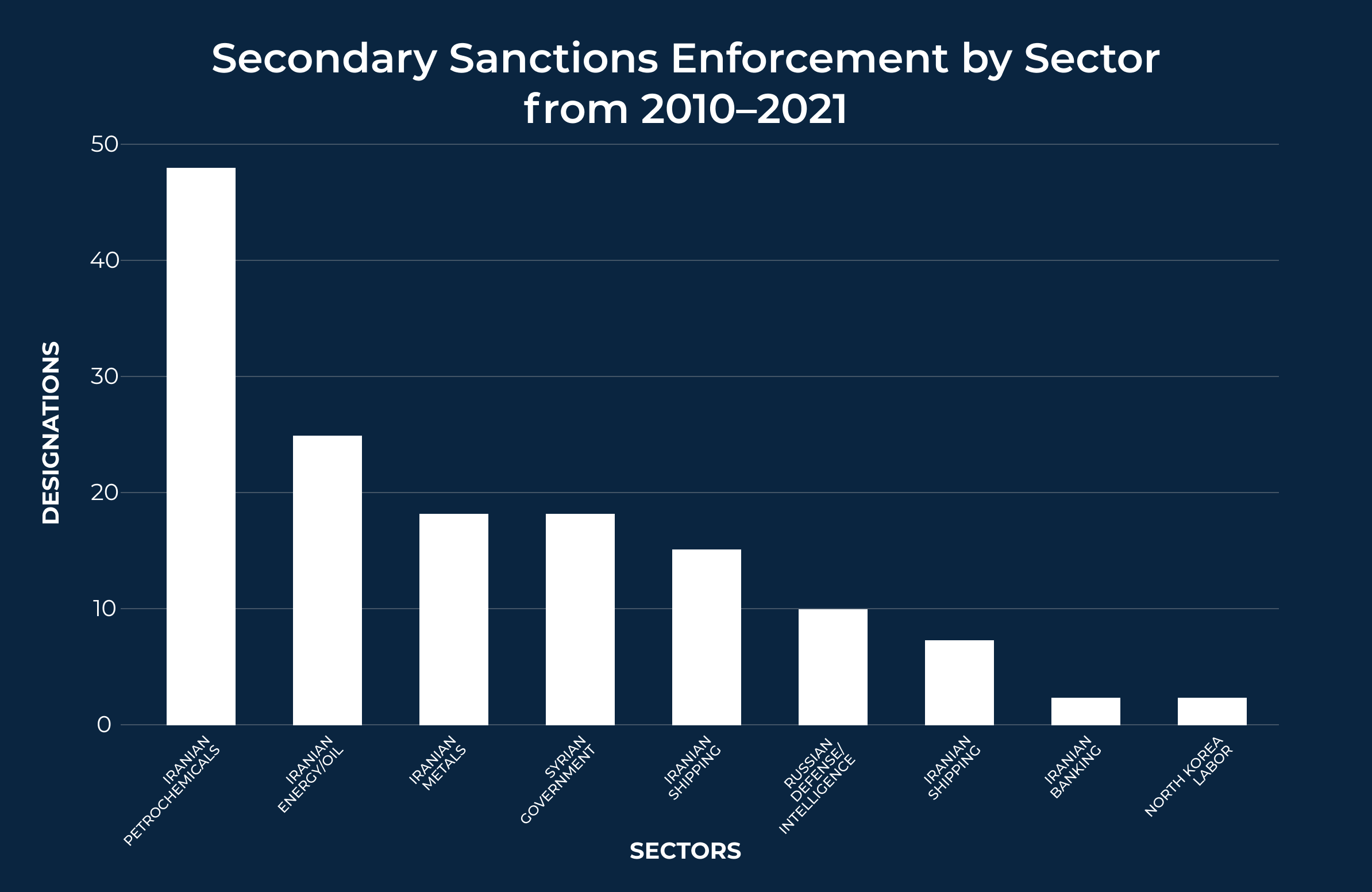Evolution of Secondary Sanctions And Challenges for Financial Institutions

Introduction
The end of superpower rivalry in the Cold War and the emergence of new conflicts and challenges might have changed the focus of sanctions policies but did not diminish their use.
In fact, the emergence of new global challenges in the 1990s—ranging from rogue states to international terrorism—only expanded the role of sanctions in foreign policy. The use of secondary sanctions by the United States to target adversaries is the most common example of how sanctions are now being used as foreign policy tools.
While primary sanctions have long been used to directly target adversaries, secondary sanctions have emerged as a potent instrument, impacting not only the targeted nations but also third-party countries.
Secondary sanctions first appeared as a foreign policy tool during the Cold War, particularly as the United States sought to assert its dominance and control over third-party nations engaging with adversaries. This period marked the beginning of the U.S. solidifying its global influence through sanctions, a practice that would evolve significantly in the decades to follow.
Understanding Secondary Sanctions Through the Lens of Unilateralism
To fully understand the concept of secondary sanctions, first you need to get familiar with the term ‘Unilateralism’. In the world of international relations, unilateralism is an approach in which states act without regard to the interests of other states or without their support. Unilateralism is usually contrasted with its opposite approach, multilateralism which is simply acting cooperatively with other states.
Secondary sanctions, particularly in recent years, have predominantly taken a unilateral form, with the United States at the forefront.
Secondary Sanctions In the Context Of Hegemonic Stability Theory
Implementation of secondary sanctions can also be explained through the lens of Hegemonic Stability Theory. This theory posits that a single, dominant state (the hegemon) is necessary to maintain order in the international system. The hegemon provides public goods, such as security and economic stability, through its dominance.
Secondary sanctions can be viewed as an exercise of hegemonic power, where the dominant state (like the U.S.) enforces its own rules on other states to maintain its position of authority.
The U.S. has often used secondary sanctions to reinforce global financial systems and norms in line with its strategic goals, thereby sustaining its hegemonic position.
Primary Sanctions vs. Secondary Sanctions—Why Enforcement Can Be Different?
In the context of the United States, while primary sanctions may be used to target the adversaries and secondary sanctions for targeting the third parties dealing with these adversaries, the manner of enforcement may not be distinct given the hegemony of the United States financial system.
Due to the dominance of the US dollar, the primary sanctions vs secondary sanctions enforcement approach is a subject of debate.
For instance, In some of the cases, United States primary sanctions not only apply to the US based citizens and entities but also to the transactions related to sanctioned entities, processed in US dollars, or using the US financial system, which are processed by non-US entities in the third countries.
This implies that the United States can impose monetary penalties to the third parties for violations of the United States sanctions if a US nexus, such as payment processing through the United States financial system, has been used.
This approach is debated given the fact that secondary sanctions not only apply to the third parties dealing with sanctioned entities but also to the third parties dealing with sanctioned entities without any US nexus (such as without use of the United States financial system).
Secondary sanctions enforcement doesn’t usually imply enforcement through monetary penalty but restrictions to access the US markets and US financial system.
Challenges Arising from Different Enforcement Approach of Primary and Secondary Sanctions
Sanctions compliance with the United States sanctions regimes is challenging for International Financial Institutions due to differences in enforcement actions arising as a result of primary vs secondary sanctions implications.
For instance, monetary fines imposed on financial institutions by the United States for the violation of US sanctions may be deemed as violation of secondary sanctions by the jurisdiction in which they are imposed but they may appear as violation of primary sanctions from the perspective of the United States.
A vast literature has categorized some of the monetary penalties imposed by OFAC on international financial institutions due to violations of secondary sanctions. However, from the United States perspective these could have been a violation of primary sanctions, instead of secondary sanctions due to potential involvement of US nexus.
Tom Ruys and Cedric Ryngaert have highlighted this dilemma in their paper and have discussed this at length:
Authors have elaborated that US secondary sanctions for their retaliatory nature aim at cutting off foreign parties from accessing the US financial and commercial markets, instead of imposing monetary penalties on them,
However, despite recognizing this distinction, Tom and Ryngaert have adopted a broader notion to measure secondary sanctions which also impose monetary penalties on the third countries for engaging in economic transactions with the sanctioned entities. The paper further mentions that United States literature may consider such sanctions as Primary in nature.
US economic sanctions imposed on the third countries require elaborate differentiation on the basis of primary vs secondary sanctions because of the dominance of the United States financial system leading to presence of US nexus even in transactions related to foreign entities.
Evolution of US Secondary Sanctions with Changing Geopolitical Landscape
Below is a brief account of how United States economic sanctions programs have evolved over the years along with geopolitical shifts.
Cold War & Birth of Secondary Sanctions
Secondary sanctions, while a powerful tool today, were relatively underdeveloped during the Cold War. Initially tied to restricting access to U.S. markets and financial systems for countries engaging with Soviet-aligned nations, sanctions were primarily seen as a geopolitical strategy to isolate adversaries.
This period saw sanctions as an extension of geopolitical strategies aimed at isolating the Soviet bloc from Western economic systems.
U.S sanctions in the 1990s entailed more cooperation, however, the proliferation of economic sanctions in the 1990s generated considerable backlash, not just in the United States but also in the United Nations and among U.S. trading partners.
From the standpoint of the international community, the most concerning feature of the secondary sanctions launched in the 1990s was the secondary boycott, threatened, and invoked against third parties that dealt with target countries. This implies that certain jurisdictions may have retaliatory legal measures to counter impact of extraterritorial sanctions, a term often used interchangeably with the secondary sanctions.
However, secondary sanctions were relatively underdeveloped and rarely used, as primary sanctions—direct sanctions on the adversaries—were the predominant tool.
Collapse Of Soviet Union & Widespread Use of Secondary Sanctions
After the collapse of the Soviet Union and the end of the Cold War in 1989, the global political landscape shifted, and secondary sanctions began to evolve into more preferred tools.
As new global challenges emerged, particularly the rise of rogue states, international terrorism, and the proliferation of nuclear weapons, secondary sanctions became a way for powerful countries like the United States to exert influence over not just their adversaries, but also over third-party nations or entities that engaged in trade or financial transactions with sanctioned countries.
The 1990s saw the beginning of their implementation, notably through sanctions targeting states like Cuba, Iran, and Libya, which aimed to curb their support for terrorism and nuclear ambitions.
The Iran Sanctions Act (ISA) of 1996
One of the earliest and most significant applications of secondary sanctions came with the Iran Sanctions Act (ISA) of 1996, which was designed to limit foreign investments in Iran's energy sector.
The act allowed the United States to impose sanctions on foreign companies that invested more than $20 million in Iran's oil industry, effectively creating a situation where foreign companies had to choose between doing business with Iran or maintaining access to U.S. markets.
This marked a turning point in the use of the US secondary sanctions, as it expanded their application beyond simple economic pressure, forcing non-U.S. companies to align with U.S. foreign policy objectives. In later years, the ISA was also extended to cover Libya, showing its broader applicability.
Expansion During the War on Terror (2001-2010)
Following the September 11 attacks in 2001, the U.S. government significantly expanded its sanctions regime, and secondary sanctions became a critical element in the broader fight against terrorism financing.
The Patriot Act empowered the U.S. Treasury Department to target not just individuals or groups engaged in terrorism but also any foreign banks or businesses that provided them with financial services or support.
This era saw an intensification of secondary sanctions, with a focus on cutting off terrorist networks from the global financial system. In particular, secondary sanctions were applied to any entity found to be doing business with individuals, groups, or nations identified as supporting terrorism, such as Iran or North Korea.
Iranian Nuclear Deal & Augmented Secondary Sanctions
Secondary sanctions reached their peak in the 2010s, particularly during the lead-up to the Joint Comprehensive Plan of Action (JCPOA), commonly known as the Iran nuclear deal.
Secondary sanctions enforcement escalated considerably following the United States' withdrawal from the Joint Comprehensive Plan of Action in 2018, followed by the reinstatement and expansion of secondary sanctions on Iran. (US Department of Treasury Office of Foreign Assets Control and US Department of State.)
The Obama administration used secondary sanctions as a powerful tool to bring Iran to the negotiating table. In 2012, the National Defense Authorization Act (NDAA) for Fiscal Year 2012 imposed secondary sanctions on foreign financial institutions that conducted significant transactions with Iran's central bank, effectively cutting off Iran from the international financial system.
These sanctions pressured countries like China, India, and Turkey to reduce their imports of Iranian oil, showcasing the global reach and effectiveness of secondary sanctions in achieving diplomatic objectives.
Modern Geopolitics and Secondary Sanctions
In recent years, secondary sanctions have become a key component of U.S. foreign policy, particularly in relation to countries like Russia, North Korea, Venezuela, and Syria.
The Countering America's Adversaries Through Sanctions Act (CAATSA) of 2017 was one of the most significant pieces of legislation in recent years that expanded secondary sanctions.
It targeted foreign entities doing business with Russia in key sectors such as defense, energy, and banking, following Russia's annexation of Crimea and its interference in U.S. elections.
The wide-ranging scope of secondary sanctions under CAATSA reflected the U.S.'s increasing reliance on this tool to enforce international norms and pressure foreign governments, businesses, and even individuals.
Secondary sanctions remain a controversial but highly effective method of compelling third-party compliance with U.S. foreign policy goals in an increasingly multipolar world.
Secondary Sanctions Implementation Challenges for Financial Institutions
Now lets talk about how secondary sanctions impact businesses and financial institutions. These sanctions don’t just affect them directly but create ripple effects that impact revenue, reputation, and overall operations. Imagine trying to expand into a new market, only to find that a past connection or transaction with a sanctioned entity blocks your path.
That's the reality for many businesses!
Let’s learn about some of the biggest challenges they face and explore how these issues play out in real life.
1. Reduced Access to Markets
Businesses and financial institutions may also face reduced access to foreign markets due to secondary sanctions risks. This is because doing business with the sanctioned entities implies that foreign financial institutions may lose access to the United States financial system or even end up getting sanctions.
2. Increased Risk of Litigation
The risk of litigation is another major headache for businesses. A classic example is the Huawei case. In 2019, a U.S. company sued Huawei, claiming that it violated U.S. sanctions on Iran. This came on top of numerous lawsuits the company faced due to its links with sanctioned entities. These legal battles drained resources and damaged Huawei's relationships with global partners, proving that secondary sanctions don't just end with fines—they can open the door to a slew of lawsuits from affected parties.
3. Navigating the Conflicting Regulations
Very often secondary sanctions face criticism for being in violation of international law. Hence, countries come up with their own laws to ensure that extraterritorial sanctions by foreign nations don’t impact their trade prospects with other nations. In such cases, financial institutions operating internationally may need comprehensive information to do a cost-benefit analysis to know whether they should comply with secondary sanction regulation by a foreign country or a counter-regulation in their own country which prevents them from compliance with foreign country’s law.
Compliance Strategies for Dealing with Secondary Sanctions
When companies deal with secondary sanctions, it’s not just about ticking boxes. It’s about dealing with a complex landscape where even a small misstep can lead to million dollar fines or a damaged reputation.
Talking about secondary sanctions implementation challenges in the case of the United States, it is essential that obligated entities such as foreign financial institutions that can’t afford to lose access to the United States financial markets must know the exact context of each sanction designation and subsequent Executive Order pursuant to which each designation has been issued.
Why Knowing the Context to United States Secondary Sanctions is Crucial?
Secondary sanctions risk may have different implications. Some of these may only target selective economic sectors while others may be comprehensive, depending upon executive order under which these specially designated lists have been issued.
Foreign financial institutions doing OFAC sanctions screening to stay compliant with United States sanctions must be familiar with the exact nature of designation to know about kind of repercussions they may face as a result of doing business with a sanctioned entity or if there is any requirement to apply for a general license to trade with the sanctioned jurisdiction under certain conditions.
Further, exact categorization of primary and secondary sanctions is also essential to determine whether compliance with a foreign country’s sanctions regulations will be safe and not in contradiction with the domestic laws of the jurisdiction.
This is more relevant in the case of financial institutions in the European Union that may need to access complete information due to the conflict of US secondary sanctions with EU blocking statute, which was adopted in 1996 by the block to deter extraterritorial impact of foreign laws on EU institutes.
FFIs in the European Union may need to be familiar with the backdrop of certain US secondary sanctions risk to ensure that compliance with these sanctions is not in contradiction with EU blocking statute otherwise they risk facing lawsuits from their own country too.
Enforcement by Imposing Monetary Penalty and by Cutting Access to US Markets for Violation of OFAC Sanctions
BNP Paribas
In 2014, French bank BNP Paribas was fined for conspiring to violate the International Emergency Economic Powers Act (IEEA) and Trading With Enemy Act (TWEA). It was the first time that a big global bank had agreed to enter into a guilty plea for violation of the United States economic sanctions.
While enforcement related to BNP Paribas had a US nexus as the bank had provided dollar clearing services to entities associated with Sudan, Iran and Cuba, it has been referred to as a violation of the United States secondary sanctions in literature.
Standard Chartered Fine Fine from (2008-2014)
Standard Chartered Bank had been fined $1.1bn by the United States authorities for conducting dollar transactions on behalf of sanctioned entities and allowing sanctioned entities access to the US financial system. Various fines comprising $667 million in 2012, $300 million in 2014, and $600 million from 2008-2014. While all sanctions violations had taken place in third countries the use of the US dollar and US financial system was the US nexus here.
Chinese Telecom ZTE Fine
ZTE had been fined $1.1bn. for shipping the US-made goods to North Korea and Iran. The company sent goods to North Korea without export license. This enforcement has also been referred to as a result of secondary sanctions violations. The US-nexus in this particular case is shipping of the US-made goods.
Bank of Dandong Enforcement 2017
One of the prominent enforcement for secondary sanctions is related to China’s Bank of Dandong. On November 2, 2017 United States Financial Crimes Enforcement Network, severed the chinese bank, Bank of Dandong’s access to US financial system for conduit related to illicit North-Korean financial activity. FinCen prohibited the US financial system from opening correspondent accounts on behalf of Bank of Dandong. Enforcement in the case of the Bank of Dadong was in form of cutting access to the US financial markets.
Strategies to Comply with OFAC Secondary Sanctions for Foreign Financial Institutions
As discussed above foreign financial institutions may need to adopt a cautious approach during OFAC sanctions screening processes for complying with the US sanctions regulations. This is due to the wide scope of United States primary sanctions as viewed through the lens of US literature and non-compliance with the US secondary sanctions which could lead to loss of access to US financial system and markets.
Here are a few of the strategies that FFIs should adopt to ensure robust compliance with the US sanctions regime.
Use A Sanctions Screening Tool with Comprehensive Outcomes and Contexts
Lower false positives and zero false negatives are indeed significant parameters to evaluate the efficiency of a sanctions screening tool but they are not the only ones. Sanctions regulations are very complex. Knowing whether an entity is sanctioned is not the only thing that matters, the context is important here.
Officials responsible for screening against OFAC sanctions list may also need to know more details like corresponding executive order under which a respective Specially Designated List has been issued and whether a name in SDN carries a secondary sanctions risk or not.
For instance, updated OFAC Sanctions Advisory as of June 2024 mentions one of example of control to mitigate sanctions risk as “Screening transactions, customers, counterparties, and associated parties against relevant sanctions lists, such as OFAC’s Specially Designated Nationals and Blocked Persons List (SDN List), to prevent the provision of any service to persons blocked pursuant to E.O. “
Invest in Compliance Training
Since the United States sanctions regime is quite complex, foreign financial institutions need to ensure that their sanctions compliance teams are able to evaluate each designated name on the basis of the particular sanctions regime. This is more important when a financial institution faces conflict between foreign law and jurisdiction’s specific law and has to make an informed decision.
For a sanctions compliance official it is important to be equipped with knowledge of the US sanctions regime. To assist with this knowledge, a sanctions screening tool with accurate and real-time data which is backed by comprehensive information and accurate labeling of potential sanctions related risks is crucial.
Conduct Enhanced Due Diligence
At the end of the day, compliance with secondary sanctions often boils down to one thing: knowing who you’re doing business with. This is where enhanced due diligence comes into play. Don’t just take a quick look at your business partners—dig deeper.
One major challenge in conducting enhanced due diligence is lack of access to information. A sanctions screening tool which lacks the context to a designation may not prove that much instrumental in helping with enhanced due diligence.
Ultimately, secondary sanctions are here to stay, and as geopolitical tensions rise, businesses must brace for more. The ones that thrive will be those that not only comply but anticipate the next moves of global regulators.
As the United States Office of Foreign Assets Control adds secondary sanctions risk to more SDN lists, the compliance challenges for foreign financial institutions increase. As global sanctions become more complex, financial institutions and businesses operating globally need advanced sanctions screening solutions that assist with added context along with accurate and real-time data.
In the absence of complete information about sanctioned entities, making decisions in line with the risk-based approach and in line with the organization’s risk-appetite, becomes difficult.
AML Watcher’s advanced sanctions screening tool adds secondary sanctions risk to the sanctions screening outcome, helping with accurate decision making instead of de-risking.
A distinct secondary sanctions label allows obligated sectors to distinguish between primary and secondary sanctions, providing obligated sectors the confidence to manage risks while remaining compliant. Not all high-risk clients must be excluded—our updated labeling system allows you to securely integrate those with manageable hazards.
A clear classification of primary and secondary sanctions now allows screening officials to determine if a customer comes under primary or secondary sanctions, providing you the freedom to onboard individuals that pose a reduced, acceptable risk after complete due diligence.
Contact us today to learn how our solutions can help you stay compliant and protect your business from the impact of secondary sanctions!
Insights
Additional Insights
Check out related resources for further insights into relevant topics.
Subscribe to our Newsletter
Our best articles, news and stories, delivered to your inbox every week.






 Insights
Insights
 Insights
Insights
 Insights
Insights